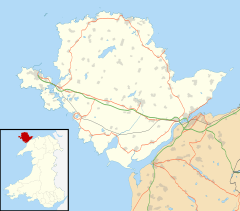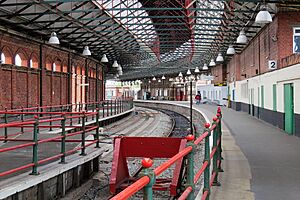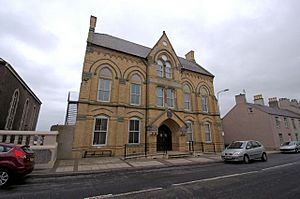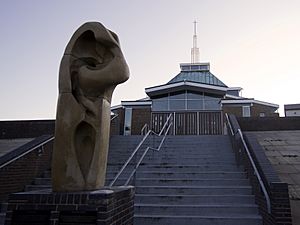Holyhead facts for kids
Quick facts for kids Holyhead
|
|
|---|---|
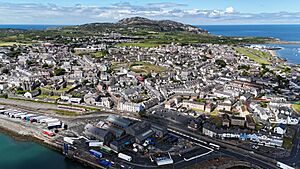 Town skyline |
|
| Population | 12,084 2011 Census |
| OS grid reference | SH2482 |
| Community |
|
| Principal area | |
| Ceremonial county | |
| Country | Wales |
| Sovereign state | United Kingdom |
| Post town | HOLYHEAD |
| Postcode district | LL65 |
| Dialling code | 01407 |
| Police | North Wales |
| Fire | North Wales |
| Ambulance | Welsh |
| EU Parliament | Wales |
| UK Parliament |
|
| Welsh Assembly |
|
Holyhead is a historic port town in Wales. It is the largest town and a community in the county of Isle of Anglesey. Holyhead is located on Holy Island. The Irish Sea borders it to the north. A narrow stretch of water called the Cymyran Strait separates Holy Island from Anglesey island. Originally, a bridge called the Four Mile Bridge connected the two islands.
In the mid-1800s, Lord Stanley helped fund a larger causeway. This causeway is known locally as "the Cobb". Today, it carries the A5 road and the railway line. The A55 dual carriageway runs next to the Cobb on a newer causeway.
The town is home to the Port of Holyhead. This is a very important port for ferries traveling to Ireland. In 2021, the town's population was 12,084 people.
Contents
What's in a Name?
The English name Holyhead has been used since at least the 1300s. It means "holy head" or "holy place". This name shows how important the area's religious history was.
The Welsh name for the town is Caergybi. This name comes from the old fort that the town grew around. Caergybi means "Cybi's fort" or "Cybi's resting place". Before the fort became famous, the small villages here were called things like "church of the Irish" or "church of the graves".
A Look Back in Time
Ancient and Roman Times
Holyhead's Old Town is built around St Cybi's Church. This church is inside a very old Roman fort. This fort is special because it has only three walls. The fourth "wall" was the sea, which used to come right up to the fort. The Romans also built a watchtower on top of Holyhead Mountain. This watchtower was inside an even older prehistoric hillfort called Mynydd y Twr.
People have lived in this area since ancient times. You can find circular huts, burial chambers, and standing stones here. In fact, this area has one of the highest numbers of these ancient sites in Britain. Today's lighthouse is on South Stack, on the other side of Holyhead Mountain.
The Soldiers Point Hotel, near the breakwater park, was built in 1848. It was originally the home of an engineer working on the Holyhead Harbour improvements. A fire badly damaged it in 2011.
Special Conservation Areas
Holyhead has three special areas that are protected for their history and beauty. The Holyhead Central Conservation Area covers the old town center around the Roman Fort. The Holyhead Beach Conservation Area is near the Newry promenade. The Holyhead Mountain Conservation Area is north of the village of Llaingoch.
How Transport Shaped Holyhead
The Port's Story
In the early 1800s, people debated which port would be the main link between London and Dublin. It was a choice between Porthdinllaen and Holyhead. Holyhead was chosen because Thomas Telford had built better roads to it.
Holyhead became very important for sea travel in the 1800s. It has a 1+3⁄4-mile-long (2.8-kilometre) sea breakwater. The Holyhead Breakwater is the longest in the UK. It was built to create a safe harbor for ships during storms. These ships were often on their way to Liverpool and other industrial ports.
Throughout the late 1700s and 1800s, Holyhead was a key stop for important people traveling between Ireland and London. This included politicians and military officials. The port grew a lot to handle the increasing number of passengers. By 1814, about 14,000 passengers used the port each year. After the 1800 Act of Union with Ireland, many improvements were made. The South Stack Lighthouse was lit in 1809. A new harbor was built in 1810. A huge breakwater was added between 1848 and 1873. Mail service through Holyhead stopped for a short time in 1838. But it started again in 1850 when the north Wales coastal railway was built.
Road Connections
Thomas Telford built a special road from London. This road made Holyhead even more important as the place where the Royal Mail was sent to and from Dublin. The A5 road ends at Admiralty Arch. This arch was built between 1822 and 1824. It was designed by Thomas Harrison to remember King George IV's visit in 1821. He was on his way to Ireland. This marked the best time for mail coaches in Ireland. Holy Island and Anglesey are separated by the Cymyran Strait. People used to cross it on the Four Mile Bridge. It was called that because it was 4 miles (6 kilometres) from Holyhead on the old turnpike road.
Railway Links
When the railway from London to Liverpool opened, Holyhead lost the London-Dublin mail contract in 1839. The mail went through Port of Liverpool instead. The Irish Mail service returned to Holyhead only after the Chester & Holyhead Railway was finished in 1850. A new Holyhead railway station was also built. The trains were operated from London Euston.
Getting Around Holyhead
The Port of Holyhead is a very busy ferry port. Two large ferry companies, Stena Line and Irish Ferries, operate from here. Ferries sail to Dublin.
Holyhead railway station is the end of the North Wales Coast Line. You can catch trains here from Avanti West Coast and Transport for Wales. Avanti West Coast trains go directly to London Euston. Transport for Wales trains go to Cardiff and Birmingham International. They also run trains to Manchester Piccadilly.
The train and ferry stations are connected to the town center by The Celtic Gateway bridge. This bridge is for people walking and cycling.
The Stanley Embankment, also called The Cob, connects Anglesey and Holy Island. It carries the railway line and the A5 road. Thomas Telford designed and built this embankment. It was needed for a more direct route when the A5 road was being built. Construction started in 1822 and finished a year later. It is named after John Stanley, 1st Baron Stanley of Alderley, who was a kind person who helped the local area.
In 2001, the A55 North Wales Expressway was extended to Holyhead. This gave the town a dual carriageway connection to the rest of North Wales and the main British motorway network. The A55 is part of a European road route called E22.
Local bus services are mainly provided by Arriva Buses Wales. They operate services around Anglesey and to Bangor.
What Holyhead Makes and Does
Until 2009, Holyhead's main industry was a huge aluminium smelter. This factory was run by Anglesey Aluminium. A large jetty in the harbor received ships from Jamaica and Australia. These ships carried alumina, which is used to make aluminium. The alumina was moved to the plant on a conveyor belt that ran under the town. Now, the jetty can be used for visiting cruise ships.
The aluminium plant got its electricity from Wylfa nuclear power station. This power station was near Cemaes Bay. However, Wylfa was getting old and could only generate power until 2012.
The Holyhead Port is a major employer in the town. Most jobs are linked to the ferry services to Ireland. These services are run by Stena and Irish Ferries. Other important employers include Holyhead Boatyard, Gwynedd Shipping, and Eaton Electrical.
Before the end of 2020, the port was the second busiest in the UK for roll-on roll-off cargo. About 450,000 lorries took ferries to Dublin each year. After the Brexit withdrawal agreement, freight traffic from Ireland dropped by 50% in January 2021.
Holyhead's Weather
Like the rest of Wales and the British Isles, Holyhead has a maritime climate. This means it has cool summers and mild winters. It often has strong winds because it is by the Irish Sea. The closest weather station is at RAF Valley, about five miles southeast of the town.
On November 23, 1981, Holyhead was hit by two tornadoes. One of them was very strong, causing damage to about 20 homes and destroying a mobile home.
| Climate data for RAF Valley (1991–2020) | |||||||||||||
|---|---|---|---|---|---|---|---|---|---|---|---|---|---|
| Month | Jan | Feb | Mar | Apr | May | Jun | Jul | Aug | Sep | Oct | Nov | Dec | Year |
| Mean daily maximum °C (°F) | 8.4 (47.1) |
8.4 (47.1) |
9.8 (49.6) |
12.1 (53.8) |
15.0 (59.0) |
17.2 (63.0) |
18.8 (65.8) |
18.8 (65.8) |
17.3 (63.1) |
14.3 (57.7) |
11.3 (52.3) |
9.1 (48.4) |
13.4 (56.1) |
| Mean daily minimum °C (°F) | 3.8 (38.8) |
3.6 (38.5) |
4.5 (40.1) |
6.1 (43.0) |
8.6 (47.5) |
11.0 (51.8) |
12.9 (55.2) |
13.1 (55.6) |
11.6 (52.9) |
9.2 (48.6) |
6.6 (43.9) |
4.4 (39.9) |
8.0 (46.4) |
| Average rainfall mm (inches) | 74.6 (2.94) |
62.0 (2.44) |
57.0 (2.24) |
54.4 (2.14) |
52.4 (2.06) |
57.1 (2.25) |
57.4 (2.26) |
69.2 (2.72) |
73.9 (2.91) |
101.6 (4.00) |
103.3 (4.07) |
93.3 (3.67) |
856.3 (33.71) |
| Average rainy days (≥ 1 mm) | 14.1 | 11.6 | 11.2 | 10.9 | 9.3 | 9.3 | 10.5 | 10.6 | 11.0 | 13.9 | 16.3 | 15.8 | 144.5 |
| Mean monthly sunshine hours | 60.6 | 85.1 | 131.7 | 181.8 | 233.4 | 219.3 | 205.5 | 187.9 | 150.7 | 107.9 | 62.5 | 48.3 | 1,674.7 |
| Source: Met Office | |||||||||||||
How Holyhead is Governed
Holyhead has two levels of local government. There is the Holyhead Town Council and the Isle of Anglesey County Council. The town council meets at Holyhead Town Hall on Newry Street. It has sixteen councillors who are elected from seven local areas.
In the past, Holyhead had a "local board" that governed the town. This board became an "urban district" council in 1894. Holyhead Town Hall was finished in 1875. It was used for public events and as a meeting place for the council. The Holyhead Urban District was removed in 1974. Its area then became a "community". The county council now handles the larger government tasks.
Famous People from Holyhead

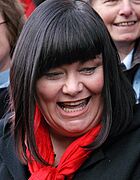
- Captain John Macgregor Skinner (1761–1832) moved to Holyhead in 1793. He was a master on ships that traveled between Holyhead and Dublin. An obelisk was built in his honor. His house is now part of the Holyhead Maritime Museum.
- John Russell (1893–1917) was born in Holyhead. He won the Victoria Cross for bravery.
- R. S. Thomas (1913–2000) was a Welsh poet and priest who grew up in Holyhead.
- David Crystal (born 1941) is a linguist who lives in Holyhead. He is also involved with the Ucheldre Centre.
- Glenys Kinnock (1944-2023) was a politician and a Member of the European Parliament. She went to Holyhead High School.
- Dawn French (born 1957) is a famous comedian and actress. She is known for her show French and Saunders.
Culture and Fun
Holyhead has an arts center called the Ucheldre Centre. It is in the chapel of an old convent. It hosts art shows, performances, workshops, and movie screenings. Holyhead Library is in the old market hall. The Holyhead Maritime Museum is in what is said to be Wales's oldest lifeboat house. The lifeboat station started in 1828.
In 2001, about 47% of the people in Holyhead could speak Welsh. The highest number of Welsh speakers was among 15-year-olds, with 66% speaking the language. By 2011, 52.2% of people born in Wales and living in Holyhead could speak Welsh.
The town's main football team is called Holyhead Hotspur. They play in the second tier of Welsh football. Holyhead Sailing Club offers sailing and kayaking. It has moorings for boats and a clubhouse with a restaurant. It is on Newry Beach. Holyhead & Anglesey Amateur Boxing Club opened in 2012. It is open to anyone over 10 years old. Holyhead's cliffs are used for coasteering. This is a water sport where people jump off cliffs into the sea. Holyhead is also the start and end point of the Anglesey Coastal Path.
Holyhead officially became "twinned" with Greystones, County Wicklow in Ireland on January 20, 2012. This means the towns have a special friendship.
See also
 In Spanish: Holyhead para niños
In Spanish: Holyhead para niños


